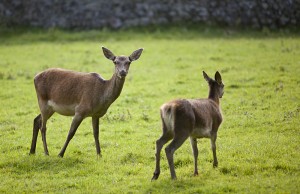Coole Park

Coole park was once the home of Lady Gregory, dramatist, folklorist and co-founder of the Abbey Theatre with William Butler Yeats and Edward Martyn. In the early 20th century, Coole was the centre of the Irish literary revival. Yeats, George Bernard Shaw, John Millington Synge, Sean O’ Casey all came to experience its magic; their initials are carved on the world famous autograph tree in the walled garden.
Coole is now a nature reserve of international repute, managed by the National Parks and Wildlife Service and comprising 405 hectares (1000)Acres of woods, lake ,river, turlough and bare limestone. The nature reserve is open daily with marked trails. The visitors centre and tea rooms open during the summer months. There are picnic tables in the Walled Garden. Free attractions include, exhibition and audio visual show. Education programmes and guided tours for groups can be booked in advance.
Coole Park which, together with the adjoining Garryland, is a Nature Reserve of approximately 405 hectares (1000 acres). The seven woods celebrated by W.B. Yeats are part of the 6 kilometres of nature trails taking in woods, river, turlough, bare limestone and Coole lake.
Coole Park the family home of Lady Augusta Gregory, dramatist, folklorist and co-founder of the Abbey Theatre with Edward Martyn of Tullira Castle and Nobel prize-winning poet William Butler Yeats. Coole Park, in the early 20th century, was the centre of the Irish Literary Revival. Yeats, George Bernard Shaw, John Millington Synge and Sean O’ Casey all came to experience its magic. They and many others carved their initials on the Autograph Tree, an old beech still standing today. Although the house no longer stands, one can still appreciate the surroundings that originally drew so many here.
There are two trails to follow. “The Family Trail” is an easy 1.75 km walk, taking you past the deer pen, the site of the house and into the walled garden to see the Autograph Tree. The 4.5 km “Seven Woods Trail” connects the different woods made famous in poetry by W.B. Yeats. Depending on the season, you might see bluebells and violets, jays and treecreepers, red squirrels and stoats, butterflies and dragonflies, or swans and other wetland birds.
“The trees are in their autumn beauty,
The woodland paths are dry,
Under the October twilight the water
mirrors a still sky;”
At Coole Park, we invite you to investigate for yourself the magic and serenity of the landscape that Yeats captured in his poetry. Through this website, you will learn about the history of the park, and its connections to the literary world, and it also provides a guide to the natural history and wildlife of the park and surrounding areas.
History
Coole estate was purchased in 1768 by Robert Gregory on his return to Ireland following service with the East India Company. It remained with the Gregory family until 1927 when it was sold to the state. Residing there at that time was Lady Augusta Gregory, already a legend in her lifetime as a dramatist, folklorist and co-founder of the Abbey Theatre with W.B. Yeats and Edward Martyn.
Lady Gregory’s love of Coole and its ‘Seven Woods’, immortalised by Yeats, is manifested in her writings and those of her literary guests.

“These woods have been well loved, well tended by some who came before me, and my affection has been no less than theirs. The generations of trees have been my care, my comforters. Their companionship has often brought me peace.”Lady Gregory, Coole, 1931
She was one of the most important figures in the Irish Literary Revival of the early 20th century, not only because of her achievements as a playwright, but also because of the way she transformed Coole into a focal point for those who shaped that movement, making it a place they would return to time and time again to talk, to plan, to derive inspiration.
But the woods and lakes at Coole were richer than Yeats divined. The ‘Seven Woods’, which so enchanted Lady Gregory and her guests, held whispers of a more ancient ancestry, of which the literary visitors were scarcely aware: remnants of the earlier natural forest cover, and the disappearing lake and river are part of the finest turlough complex (See Nature & Wildlife) not merely in Ireland but in all the world.
Lady Gregory died on 22nd May 1932. In one sense, the magic of Coole has been in abeyance since the demolition of the house in 1941, a time when more immediate concerns occupied the minds of most people. Coole-Garyland is now a statutory Nature Reserve managed by the National Parks & Wildlife Service, whose aim is to preserve its rich natural and cultural heritage.
Location and Directions
Coole Park is located just off the N18, 3km north-west of the heritage town of Gort in Co. Galway, which is in the west of Ireland.
Distances
Galway ~ 32 kilometres / 20 miles
Dublin ~ 206 kilometres / 128 miles
Limerick ~ 68 kilometres / 42 miles
53.080106,-8.830803
Contact Details:
Coole,
Gort,
Co. Galway
Telephone +353 (0) 91 631804
Fax: +353 (0) 91 631 653
Tour bookings: bookings@coolepark.ie

